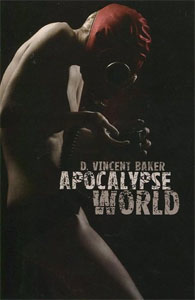All of this can be somewhat difficult to discuss because game structures have become invisible partners in our games. They are generally not spoken of. We don’t even really think about them.
 In The Elfish Gene, Mark Barrowcliffe writes: “When D&D is played it sounds like a series of questions and answers.” Similarly, in Apocalypse World, D. Vincent Baker says, “Roleplaying is a conversation. You and the other players go back and forth, talking about these fictional characters in their fictional circumstances doing whatever it is that they do. Like any conversation, you take turns, but it’s not like taking turns, right?”
In The Elfish Gene, Mark Barrowcliffe writes: “When D&D is played it sounds like a series of questions and answers.” Similarly, in Apocalypse World, D. Vincent Baker says, “Roleplaying is a conversation. You and the other players go back and forth, talking about these fictional characters in their fictional circumstances doing whatever it is that they do. Like any conversation, you take turns, but it’s not like taking turns, right?”
So as we begin looking at game structures in traditional roleplaying games, what we’re really doing is cracking open this conversation at the game table and looking at what makes it tick. And, just like a formal debate, we’re also looking at how we impose rules onto that conversation and what effect those rules have. (Some of those rules are the actual mechanics of the game, but most of them are actually looser and more universally applicable than that.)
With that in mind, let’s start by imagining ourselves sitting at a hypothetical game table. We want to start playing a traditional roleplaying game. What needs to happen?
(1) A player needs to propose an action for their character.
(2) The GM needs to adjudicate that action and provide an outcome.
Once that outcome has been determined, this cycle repeats itself. (The player proposes a new action for their character and the GM then adjudicates that action.) This is the fundamental basis for the conversation at the heart of all roleplaying games.
But, as we established at the beginning of this essay, this is not as simple as it looks. Complications arise once we consider two questions:
(1) What, exactly, is the action being resolved?
(2) How, exactly, do we resolve that action?
The first question can be largely thought of as conceptually chunking or breaking actions apart. (Is “exploring the dungeon” a single action or is it made up of many different actions?) Sometimes the GM will need to break a proposed action down into smaller actions; sometimes they’ll need to figure out how to get the player to chunk multiple actions together into a meaningful package. Ideally, of course, both player and GM would get on the same page about what type of “chunk” to propose and resolve. (And this is, of course, where shared game structures come into play.)
The second question is often answered by the mechanics of the game, but not always. (And often those mechanics will only provide a partial answer.)
For a relatively simple example at the micro-level, consider a situation in which Elizabeth the Duchess of Canterlocke is providing a formal introduction for her friend, the Duke of Donalberry. But, in reality, the Duke of Donalberry is a fraud and Elizabeth knows this (she’s trying to smuggle him into some formal affair for reasons that aren’t really important). Is this resolved with a Bluff check? If so, is the check made by the duchess or the duke? Or both? Or should the duchess make a Bluff check while the duke makes a Disguise check? If the duchess fails her Bluff check, does that mean the whole fraud has been discovered? Or does it just alert the target that something funny is going on (thus applying a penalty to the duke’s Disguise check)?
There is no “right” answer here. But which structure you choose will have a significant impact on how this scene plays out at the table.
MICRO vs. MACRO
For the sake of convenience, I’m going to conceptually break down my discussion of game structures into two types:
At the micro-level, game structures usually take the form of GM rulings: As in our example of the Duchess of Canterlocke, the PCs propose an action and the GM determines how that action will be resolved. (In some cases this ruling is straightforward – the players want to do X; there is a rule for X; the GM uses the rule – and in other cases it will require greater innovation.)
At the macro-level, game structures become scenario structures. These larger scaffoldings determine how the players move through complex environments (physical, social, conceptual, or otherwise).
For example, imagine a simple scenario concept: “The PCs go to Castle Osterkark and investigate the rumors of cultist activity.”
A GM could choose to use any number of game structures to flesh out this concept: Is it a crawl from room to room? Is there a network of clues that will take the PCs to various locations throughout the castle? Will the PCs seek out particular NPCs and question them? Is there a timeline of events? Some combination of these techniques? Some other technique entirely?
At both the macro- and micro-level, game structures have a significant impact on what happens at the actual game table.
To help us get a better grasp on what scenario structures look like in practice, let’s take a peek at the grand-daddy of them all: The dungeoncrawl.


Long time reader, first time poster. Just wanted to say that I found this series of posts (and many, many others as well) quite helpful Thanks for sharing your insights with the rest of us.
Cheers,
-Tad
[…] С оригиналом статьи Вы можете ознакомиться здесь. […]